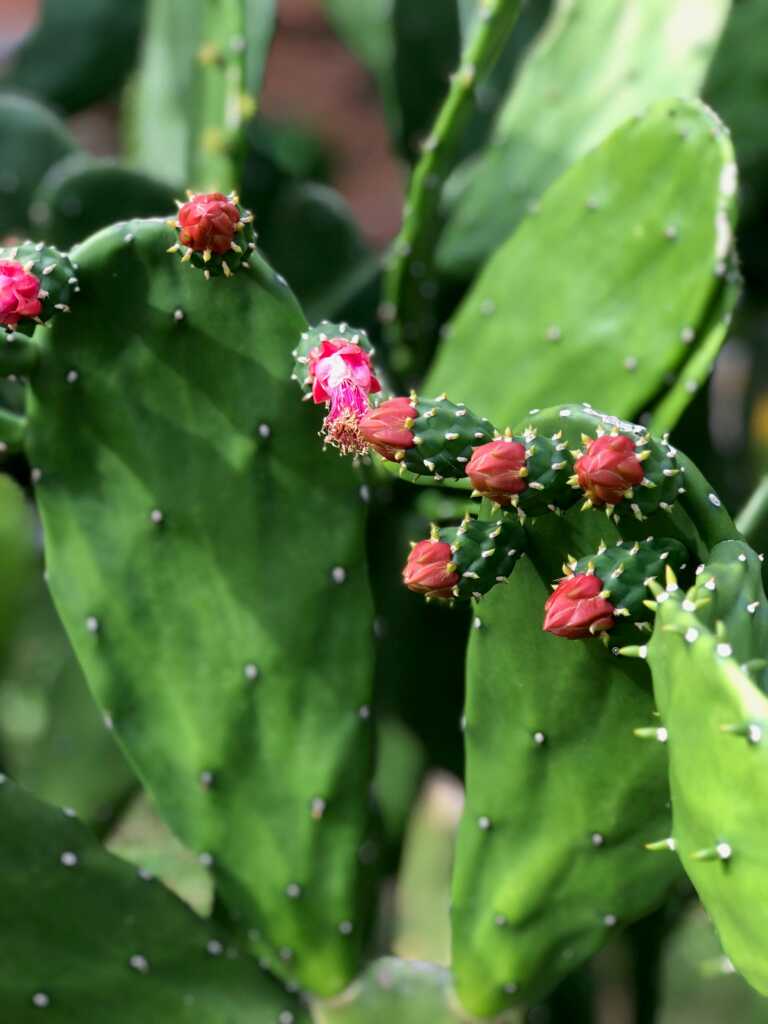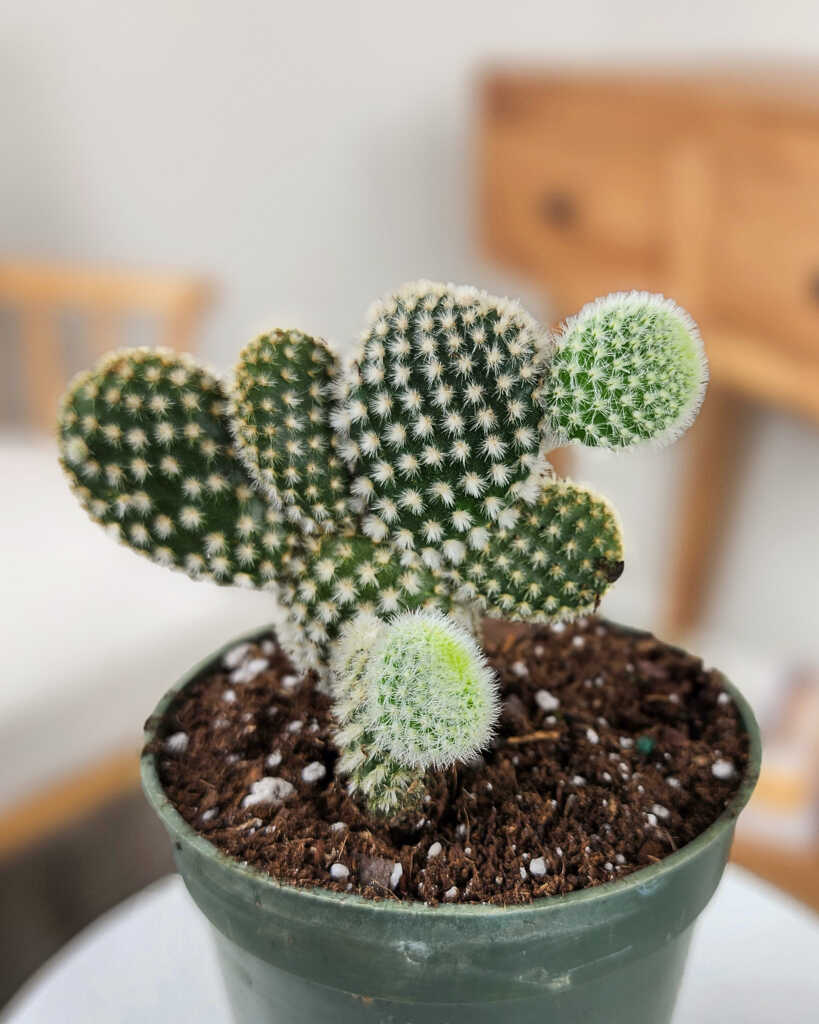Opuntia cactus, commonly known as prickly pear or paddle cactus, is a diverse and fascinating genus of plants belonging to the family Cactaceae. These iconic cacti are prized for their distinctive flattened stems, colorful blooms, and edible fruits. With proper care, Opuntia cacti can thrive indoors and outdoors, adding a touch of desert beauty to any environment. In this comprehensive care guide, we’ll explore everything you need to know to cultivate and maintain healthy Opuntia cacti.

Opuntia cacti are native to North and South America, with a natural habitat ranging from the arid deserts of the southwestern United States to the tropical forests of Central and South America. These hardy succulents are well-adapted to dry, sunny conditions and are characterized by their flattened, paddle-shaped stems, which are equipped with clusters of barbed spines.
Light Requirements
Opuntia cacti thrive in bright, indirect sunlight, making them ideal candidates for sunny windowsills or outdoor garden spaces. Place your Opuntia cactus in a location where it will receive at least six hours of sunlight per day. However, be cautious of intense midday sun, as it can scorch the delicate pads of the cactus. If growing indoors, rotate the plant regularly to ensure even sun exposure and prevent leaning towards the light source.
Temperature and Humidity
Opuntia cacti are highly adaptable to a wide range of temperatures, but they prefer warm, dry conditions reminiscent of their native desert habitats. During the growing season (spring and summer), maintain temperatures between 70°F to 90°F (21°C to 32°C) during the day and 50°F to 70°F (10°C to 21°C) at night. In the winter months, allow the plant to experience cooler temperatures between 50°F to 60°F (10°C to 15°C) to simulate its natural dormancy period.
As desert plants, Opuntia cacti have low humidity requirements and can tolerate dry air. However, they may benefit from occasional misting during periods of extreme dryness, especially when grown indoors in heated environments.
Watering
One of the most critical aspects of Opuntia cactus care is proper watering. These succulents are highly drought-tolerant and prefer infrequent but thorough watering sessions. Allow the soil to dry out completely between waterings, then water deeply until excess moisture drains from the bottom of the pot. During the active growing season, typically spring through fall, water your Opuntia cactus approximately once every two to three weeks.
In the winter months, reduce watering frequency to mimic the plant’s natural dormancy period. Water sparingly, only when the soil has become completely dry. Overwatering is the most common cause of root rot and other fungal diseases in Opuntia cacti, so it’s essential to err on the side of underwatering rather than overwatering.
Soil Requirements
Opuntia cacti thrive in well-draining soil that mimics the sandy, gravelly substrates of their native desert habitats. Choose a commercial cactus mix or create your own by combining equal parts potting soil, perlite, and coarse sand or gravel. This porous, fast-draining soil mixture prevents water from pooling around the roots and helps prevent the risk of root rot.
When repotting your Opuntia cactus, select a container with drainage holes to allow excess water to escape freely. Repotting is typically only necessary every two to three years, or when the plant has outgrown its current container.
Fertilization
Opuntia cacti have relatively low nutritional needs and can thrive without frequent fertilization. During the active growing season, you can feed your Opuntia cactus with a diluted, balanced liquid fertilizer formulated for cacti and succulents. Apply the fertilizer at half-strength every four to six weeks to provide essential nutrients without risking fertilizer burn.
Alternatively, you can use a slow-release fertilizer applied once at the beginning of the growing season to provide long-lasting nourishment. Always follow the manufacturer’s instructions and dilution rates to avoid overfertilizing, which can lead to nutrient imbalances and damage to the plant.
Pest and Disease Management
Opuntia cacti are relatively pest-resistant, but they may occasionally attract common succulent pests such as scale insects, mealybugs, and spider mites. Regularly inspect your cactus for signs of pest infestation, including discolored or distorted growth, sticky residue, or webbing.
If pests are present, gently remove them by hand or use a soft brush to dislodge them from the plant’s surface. For severe infestations, you can treat the cactus with neem oil or insecticidal soap, following the manufacturer’s instructions carefully.
In terms of diseases, Opuntia cacti are susceptible to root rot if overwatered or grown in poorly draining soil. To prevent root rot, always allow the soil to dry out between waterings and ensure proper drainage in your plant’s container. Additionally, avoid splashing water onto the cactus pads, as this can create conditions favorable for fungal growth.
Propagation
Propagating Opuntia cacti is relatively straightforward and can be done through several methods, including stem cuttings, offsets (also known as pups), and seeds. Stem cuttings should be allowed to callus over for a few days before being planted in well-draining soil. Offsets can be carefully removed from the parent plant and replanted in their own containers. Seeds should be sown in a well-draining soil mix and kept consistently moist until germination occurs.
Pruning and Maintenance
Opuntia cacti require minimal pruning and maintenance to keep them looking their best. However, you may wish to remove any dead or damaged pads with sterile pruning shears to promote healthy growth and maintain the plant’s appearance. Additionally, you can pinch back new growth to encourage branching and create a bushier, more compact plant.

White Bunny Ears Cactus
Scientific Name: Opuntia microdasys ‘Alabata’
Common Names: White Bunny Ears Cactus, Prickly pear cactus
Overview: The White Bunny Ears Cactus, scientifically known as Opuntia microdasys albata, is a charming and distinctive succulent prized for its adorable appearance and minimal care requirements. Originating from Mexico, this unique cactus earns its nickname from the fluffy, rabbit-like pads that emerge from its cylindrical stems. Its pads are covered in soft, white spines that resemble bunny ears, adding a whimsical touch to any indoor garden or succulent collection.
This low-maintenance plant thrives in bright indirect light and well-draining soil, making it ideal for windowsills or sunny spots in your home. Water sparingly, allowing the soil to dry out between waterings, especially during the winter months when it goes dormant. With proper care, the White Bunny Ears Cactus can reward you with delicate yellow flowers in the spring and summer months, adding a splash of color to its already captivating presence.
Opuntia cacti are prized for their unique appearance, easy care requirements, and resilience in a variety of growing conditions. Whether grown indoors as a potted specimen or outdoors in a desert-themed garden, these iconic cacti are sure to captivate with their striking presence and colorful blooms. By following the guidelines outlined in this comprehensive care guide, you can ensure that your Opuntia cactus thrives for years to come, bringing a touch of desert beauty to your home or garden.


